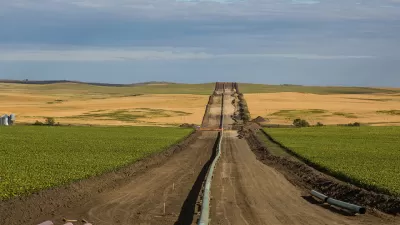Iowa Governor Terry Branstad supports the Keystone XL Pipeline, as do most Republican leaders. Then again, it doesn't go through his state. Not so for the newly proposed Bakken Pipeline that cuts across the heart of Iowa. No word on his position yet.
"Branstad told reporters Monday (July 14) at his weekly Iowa Capitol news briefing that he first learned of plans for the 1,100-mile crude oil pipeline last week from news reports. He said was not aware of the proposal by Energy Transfer Partners, L.P., of Dallas, Texas," writes William Petroski of The Des Moines Register.
"I have not taken a position on it. I just want to learn more about it," Branstad said.
However, he's already distinguished the two pipelines - giving him reason to pause before supporting the 'job-creating' pipeline "which would cut across 17 Iowa counties en route from North Dakota to Illinois," from the job-creating Keystone pipeline that doesn't go through Iowa (see map).
Branstad said that the proposed Bakken Pipeline, which would require approvals from the Iowa Utilities Board and the Iowa Department of Natural Resources, is different from the proposed Keystone XL pipeline because it would cross land that is more intensively farmed, including Iowa cropland with drainage tiles.
Pipelines can be messy, and I'm not referring to potential spills, of which we have reported many here. There's that issue of eminent domain that is sure to anger the locals. In fact, a court case involving eminent domain was cited as the reason the State Department has delayed its decision on Keystone XL.
If the pipeline is approved by the Iowa Utilities Board, the pipeline builders could use eminent domain to acquire easements to construct the pipeline through Iowa farmland, according to state officials. Branstad said eminent domain is a "controversial subject" but it can be warranted for a public purpose such as construction pipelines, roads or bridges.
Already Branstad's gubernatorial opponent has seized the issue. Grant Woodard, campaign manager for state Sen. Jack Hatch, D-Des Moines "issued a statement after Branstad's news conference with a headline claiming that the Republican governor supports the use of eminent domain for 'Big oil's pipeline across Iowa.'"
The irony is that "the volatile Bakken crude is already being transported by two freight railroads through nine Iowa counties, raising fears about possible train accidents," writes Petroski in USA Today. Placing the oil in a pipeline underground would largely eliminate the public safety threat associated with crude-by-rail explosions in Casselton, N.D. and Lac Mégantic, Quebec.
The Bakken Pipeline poses conflicts not only for Keystone supporters but Keystone opponents as well. Environmentalists who oppose Keystone and are concerned about the environmental and public safety hazards of moving millions of barrels of oil by rail daily should think carefully before staking out a position on the Bakken Pipeline.
The Sierra Club's national office has staked-out a position that "crude-by-rail is dangerous to communities" while their Iowa chapter has focused on the routing, according to USA Today.
Neila Seaman, director of the Iowa chapter of the Sierra Club, said, "We would not support the pipeline going through any protected areas or near aquifers or things like that...It is a pipeline, and pipelines break."
Hat tip to Alex Guillén and POLITICO Morning Energy, July 15.
FULL STORY: Branstad undecided on Iowa oil pipeline plans

Pennsylvania Mall Conversion Bill Passes House
If passed, the bill would promote the adaptive reuse of defunct commercial buildings.

Planning for Accessibility: Proximity is More Important than Mobility
Accessibility-based planning minimizes the distance that people must travel to reach desired services and activities. Measured this way, increased density can provide more total benefits than increased speeds.

World's Largest Wildlife Overpass In the Works in Los Angeles County
Caltrans will soon close half of the 101 Freeway in order to continue construction of the Wallis Annenberg Wildlife Crossing near Agoura Hills in Los Angeles County.

Alaska Village Becomes Test Case for Climate Change Relocation
The Yup’ik village of Newtok is the first Alaska community to begin a full-scale relocation necessitated by the impacts of climate change. Another 31 Alaska communities remain vulnerable.

Amtrak Takes Lead on Texas Central Rail
The high-speed rail project isn’t a done deal, but if it moves forward, trains could begin operating in 2030.

Maine Approves Rent Relief Program
Legislators hope the assistance program will help struggling low-income households avoid eviction.
City of Costa Mesa
Licking County
Barrett Planning Group LLC
HUD's Office of Policy Development and Research
Mpact Transit + Community
HUD's Office of Policy Development and Research
Tufts University, Department of Urban and Environmental Policy & Planning
City of Universal City TX
ULI Northwest Arkansas
Urban Design for Planners 1: Software Tools
This six-course series explores essential urban design concepts using open source software and equips planners with the tools they need to participate fully in the urban design process.
Planning for Universal Design
Learn the tools for implementing Universal Design in planning regulations.
























